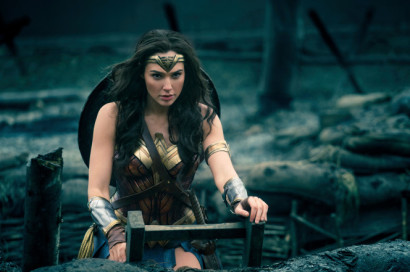‘Wonder Woman’ Wins by Being Feminist Without Bashing Men
by Heather Robinson

From The New York Post

Warner Bros.’ “Wonder Woman” continues to break records as the most successful female-led superhero action movie ever — with New York packing theaters along with the rest of the country.
So what, exactly, is winning everyone over?
What is it about this film that seems to be bringing together both men and women from all backgrounds and critics in praise?
The film’s well made, sure, with dazzling special effects and vivid scenes (see the 3-D version if you can) that create a striking contrast between worlds: from a breathtaking, female-only island where Amazons live in a fiercely athletic and secluded harmony, to the merciless front lines of World War I, where man’s inhumanity to man wrought great destruction and suffering.
The film features Israeli actress Gal Gadot as Wonder Woman, whose dark eyes sparkle with mischief, mirth and, yes, wonder, and whose compassion and determination infuse her character with a depth beyond Hollywood’s standard spirited heroines’.
At New York City theaters this week, many girls and women said they turned out because the character of Wonder Woman has been a personal inspiration in their lives, and they wanted to support the film’s director, Patty Jenkins.
“It’s nice to see a woman director given a big-budget action film, not just a rom-com,” said Mariel Conway, 30, media manager for Discovery Studios TV network, who was visiting New York from Los Angeles and attended a daytime showing at a Kips Bay theater.
Conway said that in tapping a female director, Warner Bros. is not, in Conway’s view, pandering to women but choosing the individual whom they believe to be best skilled to bring Wonder Woman to the big screen, because the company “is staking its future on the DC Comics universe.”
But the film was also striking, some noted, for what was missing: the man-hating grievance politics that sometimes accompanies a projection of female empowerment.
“It’s not a negative film, not against men, but shows women and men working together,” said Elizabeth Liumbruno, 30, an architect from Forest Hills after an evening screening in Union Square.
“Her leadership style seemed more collaborative than the typical superhero’s,” said Ellie Bastani, 33, of Morningside Heights, an assistant dean at Columbia University. “It was more about working together . . . than one person being this hero.”
“Usually you see females in supporting roles or just as sex symbols [in action films], so it’s really important for little girls to see a female in the lead,” said Bhumika Dyal, 20, a student at FIT from Ozone Park, Queens.
The film resonated with women and girls of all ages. “She did what she believed and didn’t just follow her mom,” said Chelsea Brooks, 8, of the Lower East Side, adding: “She wasn’t actually fighting, because she did want to help.”
“I loved her determination, her strength, and her compassion,” said Josie Lawrence, a retiree in Murray Hill. “I thought, ‘Yay!’ when she crossed No Man’s Land.” Lawrence added that the film is a reminder that “being a hero is not male or female.”
The film’s workmanlike plot provides sufficient momentum to carry the viewer through charming scenes in which our heroine encounters a man for the first time (Chris Pine, who plays British spy Steve Trevor, Wonder Woman’s partner in the fight to save humankind), tries on dresses in early-20th-century London and uses both her superpowers and what appears to be krav maga to fight German spies and soldiers.
But what really distinguishes the story is its heroine’s idealism, and its suggestion that the good and evil that exist in human nature cross all divides, including gender (one of the film’s chief antagonists, the sociopathic scientist Dr. Poison, is a female).
“You don’t think I wish I could tell you it’s one bad guy to blame?” Steve Trevor pleads with Wonder Woman toward the end of the movie. “We are all to blame.”
We’re facing a time when political polarization threatens civil discourse, dehumanization of one side by another cuts both ways and culture wars have recently brought millions of Americans, women prominently among them, to the streets in protest.
Perhaps the resurrection of “Wonder Woman” — an icon of female strength whose righteous anger is driven, and tempered, by compassion and love for the world — is offering little girls and women a role model for cooperative leadership, and a positive vision of empowerment they’re not seeing enough of in the real world.



